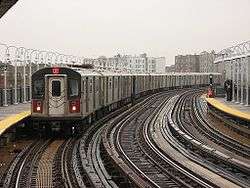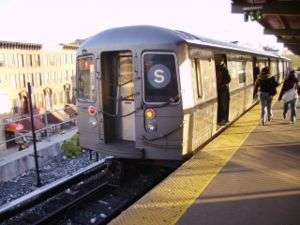R22 (New York City Subway car)
| R22 | |
|---|---|
|
| |
| Manufacturer | St. Louis Car Company |
| Built at | St. Louis, Missouri |
| Replaced | 1987 |
| Constructed | 1957-1958 |
| Number built | 450 |
| Number in service | (16 in work service) |
| Number preserved | 2 |
| Number scrapped | 431 (+1 in storage) |
| Fleet numbers | 7300-7749 |
| Capacity | 44 (seated) |
| Operator(s) | New York City Transit Authority |
| Specifications | |
| Car body construction | LAHT Carbon steel |
| Car length | 51 ft 0.5 in (15.56 m) |
| Width | 8 ft 9 in (2,667 mm) |
| Height | 11 ft 10 in (3,607 mm) |
| Doors | 6 |
| Maximum speed | 55 mph (89 km/h) |
| Weight |
General Electric cars: 77,607 lb (35,202 kg) Westinghouse cars: 78,604 lb (35,654 kg) |
| Traction system | Westinghouse 1447C or General Electric 1240A4 |
| Power output | 100 hp (75 kW) per traction motor |
| Electric system(s) | 600 V DC Third rail |
| Current collection method | Top running Contact shoe |
| Braking system(s) | WABCO ME42A |
| Track gauge | 4 ft 8 1⁄2 in (1,435 mm) |
The R22 was a New York City Subway car built in 1957–1958 by the St. Louis Car Company for the IRT division. The cars were a "follow-up" or supplemental stock for the "A" Division's R21s and are identical to the R21s. They were the last single cars built prior to the R33 World's Fair cars in 1963-1964.
Description
The fleet had two-paned storm door windows that could be opened by dropping down the upper window, though cars 7515-24 had single drop sash windows instead. Those cars also had Plextone-painted interiors and pink-molded fiberglass seats.
The R22s were the first cars to have sealed beam headlights.
History
The R22s first entered service on April 13, 1957, starting to replace most of the IRT "high voltage" type cars. The R22s ran is service for most of their service lives on the IRT Broadway – Seventh Avenue Line painted in green livery.
Cars 7513, 7509, 7516, 7654, 7675 (the interior of which Bernhard Goetz's vigilante action was filmed in), and 7686 were used as an automatic test train which ran revenue service on the 42nd Street Shuttle starting in January 1962. The experiment ended on April 21, 1964, when a fire partially destroyed the Grand Central Shuttle platform as well as car 7740.[1] Cars 7509, 7513, and 7516 were not in use at the time; thus they were not damaged in the fire, but the cars never returned to revenue service. In 1973, car 7509 was converted to the 64-foot (19.51 m) test car XC375, which operated on various IRT lines until April 1982, and scrapped on July 12, 1996.
Retirement

Though a very dependable fleet, the R22s, being single units, were not rebuilt, but replaced in the mid-1980s by the R62s and R62As. The last train made its final trip on December 30, 1987, on the 5 service with a solid consist of R21s.[2]
The following R22s are preserved or in storage:
- 7371, converted to a work car, and donated to the Seashore Trolley Museum in Kennebunkport, Maine. The car lost its original number plates and now bears number plates from other retired R22 subway cars (7370, 7373, 7435, and 7460).[3]
- 7422, converted to R95 revenue collection car 1R714. The car was retired in 2006 and is now preserved by the New York Transit Museum[4]
Several R22 cars are either preserved, in work service, or in storage:
- 7340, converted to a R123 continuous welded rail holder car for set CCR and overhauled under the R128 program.[5]
- 7446, 7505, 7657, 7659, and 7691, converted to R123 continuous welded rail holder cars for set DCR and overhauled under the R128 program.
- 7346, 7376, 7413, 7432, 7571, and 7629, converted to R71 hose reach cars and overhauled under the R159 program.[6]
- 7397, 7441, 7608, and 7633, converted to R71 de-icer cars and and overhauled under the R159 program.[7]
7486 is currently at the 207th Street Yard. The car was stripped and was to be reefed, but is now awaiting scrapping.[8][9]
16 R22s were converted to R71 rider cars after retirement, but were replaced with R161s (R33s converted into rider cars) in the mid-2000s and eventually reefed.[10]
In popular culture
A train of R22s were featured in The Taking of Pelham One Two Three, a 1974 film about the hijacking of a subway car, seen in the film as number 7339, on a downtown 6 train.
See also
- R21 (New York City Subway car) - a very similar model also built by the St. Louis Car Company.
References
- ↑ "IRT Times Square-Grand Central Shuttle". www.nycsubway.org. Retrieved 2012-10-18.
- ↑ "The IRT SMEE Fleet (R-12 - R-36)". www.nycsubway.org. Retrieved 2012-10-18.
- ↑ https://www.youtube.com/watch?v=wmRxJIrSKks
- ↑ "Showing Image 79618". Nycsubway.org. Retrieved 2012-10-18.
- ↑ http://www.nycsubway.org/wiki/R-123_Continuous_Welded_Rail_Cars
- ↑ http://www.nycsubway.org/wiki/R-71_Reach_Cars
- ↑ http://www.nycsubway.org/wiki/R-71_Rider_Cars
- ↑ mtattrain No real name given + Add Contact (2010-09-10). "R12 5782 & R22 7486 | Flickr - Photo Sharing!". Flickr. Retrieved 2012-10-18.
- ↑ "Showing Image 133737". Nycsubway.org. 2011-11-29. Retrieved 2012-10-18.
- ↑ http://nycsubway.org/wiki/R-71_Rider_Cars
![]() Media related to R22 (New York City Subway car) at Wikimedia Commons
Media related to R22 (New York City Subway car) at Wikimedia Commons



